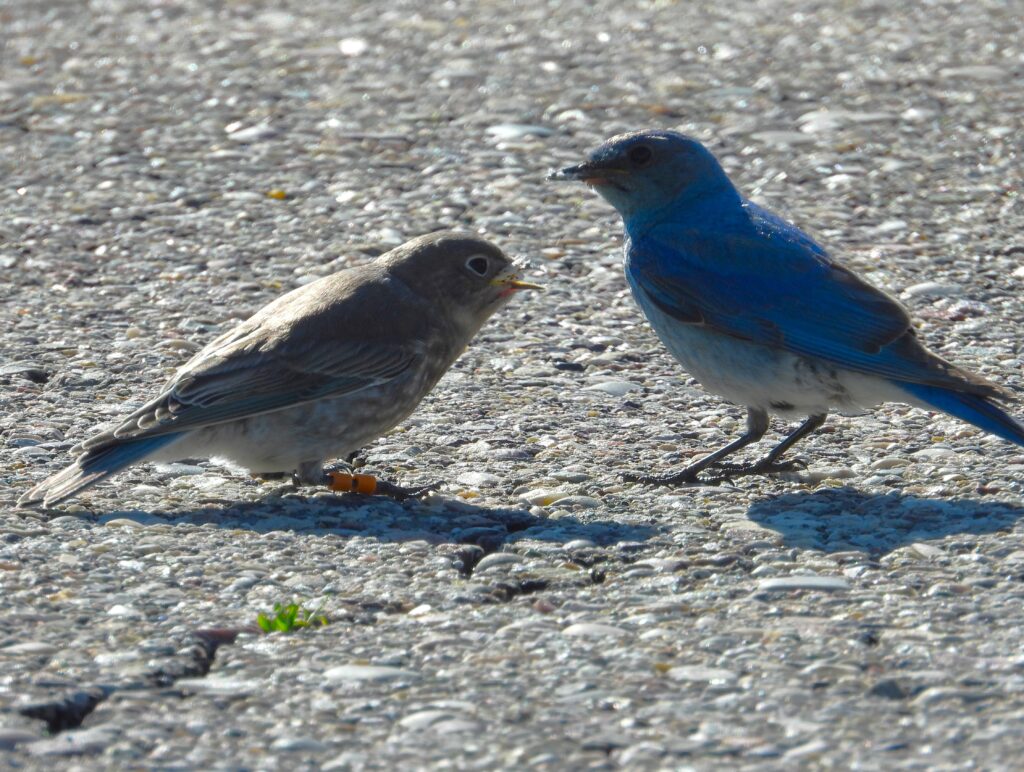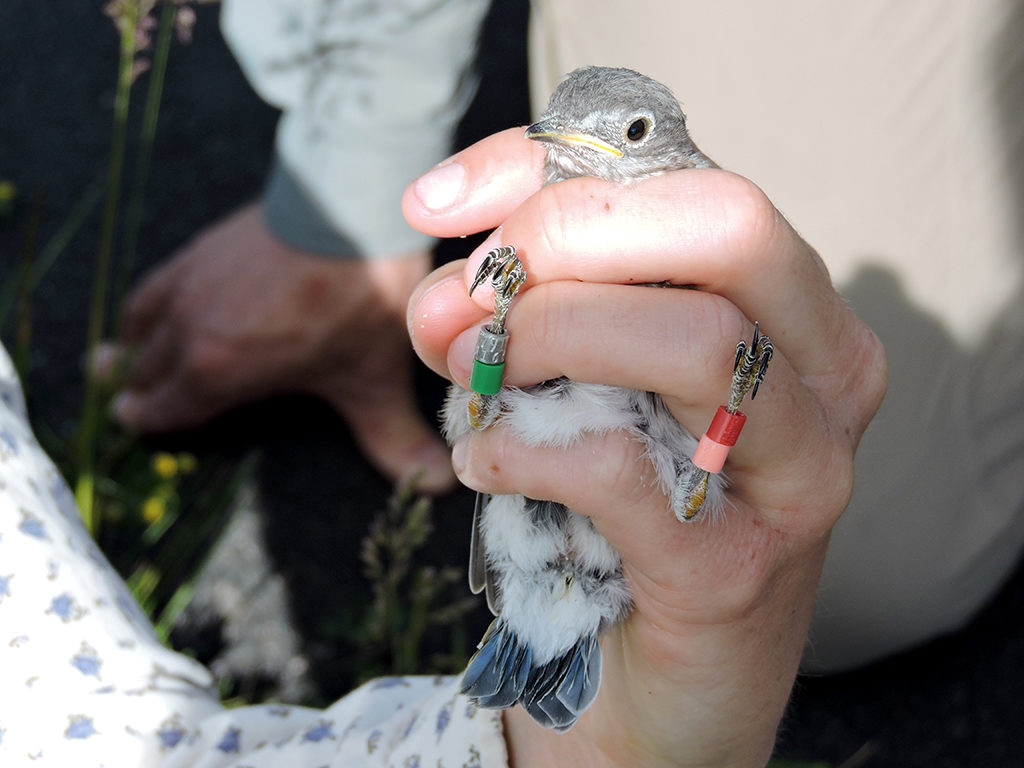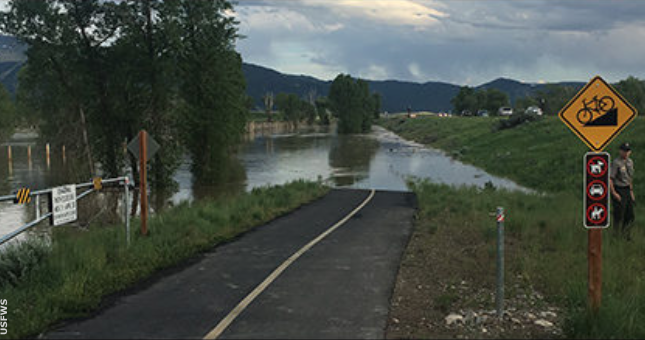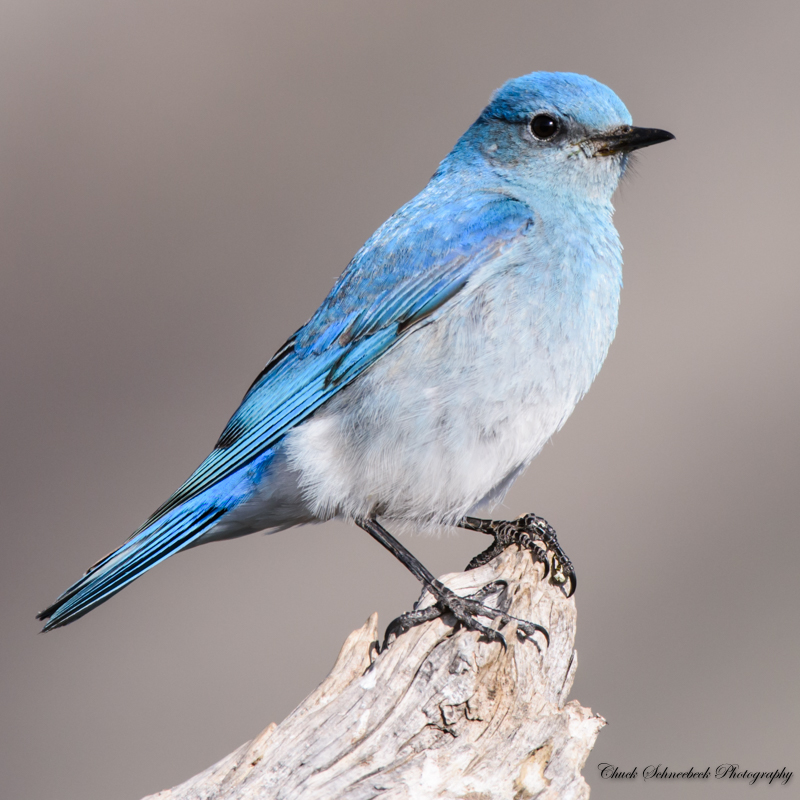
by jhwildlife | Jul 4, 2023 | Blog
By Kyle and Vicki
What purpose does our nestbox trail serve?
Mountain bluebirds are a cavity nesting species which rely mainly on holes in trees, often created by woodpeckers, to raise their young. This species of bluebird is believed to be on the decline in the West due to factors such as habitat loss and competition for limited cavity nests from invasive species like house sparrows and European starlings.

A fledgling bluebird from box 44 is fed by an adult on Monday at the Fish Hatchery. Photo Vicki Morgan.
Mountain bluebirds are among the first nesting songbirds to return to the Jackson Hole area each spring. There is likely some evolutionary strategy at play here; by returning when the ground is largely still snow covered bluebirds risk exposure to lack of food and cold temperatures, but gain an advantage over rival species when it comes to snagging limited nesting sites.
Our trail of volunteer-built nestboxes on the National Elk Refuge’s western boundary not only provides bluebirds with much needed nesting locations, but allows scientists a chance to gain a more complete understanding of the overall health of this sub-population.
How are the bluebirds faring this spring?
Overall, we’re confident 2023 has been a good year for bluebirds. While we won’t have a full dataset until the end of the summer, reports from our banding team and volunteers indicate bluebirds both returned to the trail and nested in relatively high numbers this spring.

While spring conditions imperiled some nestlings early in the season, wet conditions are likely to foster increased numbers of insects later in the summer which may benefit second rounds of nests. Photo: Vicki Morgan.
At one point, 16 active nests were recorded, more than were active over the entirety of last season. According to Lead Bird Bander Vicki Morgan, who surveys boxes and organizes volunteer data weekly, there are currently two to three boxes with nestlings about to fledge, and between four and six boxes where bluebirds are on their second attempts at nest building.
Several fledglings from box 44 were even “hanging out” at the Fish Hatchery parking lot, where they were being fed by their parents as of Monday morning (don’t all go to photograph them at once!).
The success of nestboxes this year can at least partially be attributed to last year’s batch of fledglings. At least four nest boxes contain female bluebirds which were banded last year as chicks. These birds migrated away last winter and have since completed successful return journeys back to the National Elk Refuge to build their own nests, usually within hundreds of meters from where they themselves hatched. The fancy phrase for this is “site fidelity.”
What are the challenges facing this year’s nesters?
Still, bluebirds on the nest box trail have faced challenges in 2023. While nest building jumped off to a quick start, insects were slow to emerge due to late-spring weather patterns and a handful of nests failed with a lack of available food for nestlings. While nest failure is a natural and normal process, it doesn’t mean it can’t be frustrating to witness young birds not make it, especially when you’re rooting for team bluebird! Several of our boxes have also experienced predation in recent weeks. Our best guess is that weasels are the culprit – snakes can also fit through nest box holes but generally devour young birds whole. Weasels on the other hand are prone to leaving behind “nestling bits” as evidence of their transgressions.

A 2023 fledgling with this year’s diagnostic color-band combination. Photo: Vicki Morgan
Are the nestboxes helpful for the birds?
We believe they are. Although not all nestling birds survive (you’re welcome weasels – for the buffet), the fact that many bluebirds do successfully fledge indicates the Mountain Bluebird Nestbox Project is likely having a net positive effect. Two years ago, a bird banded on our trail was recaptured and released in Texas during winter migration. And each year more and more “resights” of birds banded in previous years pour in. It’s going to take more than one productive year to help ensure the longevity of this species in our region, but that doesn’t mean we can’t get excited about this season’s results!

by jhwildlife | Aug 23, 2018 | Blog
by Kate Maley, Lead Bird Bander
Since Chuck Schneebeck started the Bluebird Trail in 2003, members of the Jackson community have endeavored to create nesting habitat for Mountain Bluebirds and other native cavity-nesters along the southwestern edge of the National Elk Refuge. After many years of observation and data collection, at least one thing is clear: the birds are definitely using the nestboxes! But what effect are the boxes having on the population?

While we focus on Mountain Bluebirds, we are equally pleased to see other native cavity nesters using the nestboxes! Tree Swallows are the most abundant nesters along the Bluebird Trail, though they arrive after most bluebirds have settled into their territories for the season.
Jackson Update:
In 2017, JHWF began expanding upon the existing data and investigating new questions when our previous bander Allison Swan and monitoring volunteers started placing USGS aluminum bands and a unique series of color bands on Mountain Bluebird nestlings and one adult female. These color bands, or “bling,” allow us to identify each individual bird as it disperses from its nest and, hopefully, returns to a similar area the following year to raise some little bluebirds of its own!
Still in the early stages of the banding project, we don’t have many definitive answers yet, but we are learning lots! Of the 98 bluebird nestlings that were banded in 2017, only a handful have been resighted this year. This isn’t as surprising as it may initially sound, however. The first year of a bird’s life is the hardest as they learn to fend for themselves and navigate migration. Optimistically, we estimate that around 50% or fewer birds make it back to their breeding grounds in their second year. Once back in Jackson Hole, they disperse from their original nest site to independently begin a family of their own. Where do they go? That’s one of the things we’re hoping to discover!

Max Frankenberry, Assistant Bander, secures the color bands on a nestling to help ensure they will stay on and be able to be spotted next year.
While migration is still a taxing journey for adult bluebirds, they do benefit from experience. In addition, adult bluebirds tend to have higher site fidelity, meaning they are more likely to return to the same site to breed for multiple years. So far, the one banded adult mountain bluebird did, in fact, return to the exact same nestbox where she was banded in 2017!
Admittedly, 2018 was a tough year for nestbox inhabitants as almost half of the nestboxes were within a stretch affected by predation events. (Exact numbers are still being determined as we close out the season and compile the data.) In response, we placed a number of predator guards that are recommended by the North American Bluebird Society. Fortunately, most of the guards did seem to effectively prevent the depredation of a second nesting attempt. Even with the challenge of a predator, nearly all of the 112 available nestboxes were occupied by native cavity nesters (Mountain Bluebirds, Tree Swallows and House Wrens). Of the Mountain Bluebird nests, about 75% successfully fledged young. In total, 72 nestlings were banded in 13 nestboxes (some had two broods throughout the season).
Now, we’ve reached the point in the season when bluebirds of all ages disperse from their nest sites and seem to gather into groups by age to take advantage of the last of summer’s bounty and fatten up before migration. So, if you keep an eye out for “Bluebirds with Bling,” you’re likely to see some from the 2018 cohort (indicated by a peach color band on the bird’s right leg, closest to the body) and possibly some from 2017 as they group up prior to beginning journey south.

Meet one of the members of 2018’s cohort of bluebirds! The location of the peach color band (top right) will allow us to easily identify it as having hatched and been banded this year. Left: Black over Green, Right: Peach over Silver
Dubois Update:
Last year was also the first year of the Dubois Community Bluebird Trail. The project continued in 2018 with 35 nestboxes monitored by 9 volunteers. We’re still waiting to finalize the data prior to analyzing the results from the season, but we’re looking forward to what we find out!
Thank you to all our hardworking volunteers and partners in both Jackson and Dubois who make this project possible!

Nancy and Blair Butterfield were kind enough to give us an update and tour of their nestboxes when we visited Dubois in July.

by jhwildlife | Jul 12, 2017 | Blog, Nature Mapping Jackson Hole
As one leaves the town of Jackson and heads north on HWY 89, a trail of nestboxes lines the fencing of the National Elk Refuge. These nestboxes are part of JHWF’s Mountain Bluebird Nestbox Monitoring Project, which is designed to mitigate for extreme habitat loss that has negatively impacted the breeding success of this species. Monitoring work has been conducted for the past 13 years, but this summer we added a new element to the project by hiring bird bander Allison Swan. With help from our volunteers, Allison has banded 98 chicks and 1 female adult since May.
With data collected through banding and the re-sighting of individuals, we will be able to evaluate survival rates of young, dispersal patterns, re-nesting rates, productivity by age, site fidelity, and other measures of population dynamics. This type of information will allow us to understand population status in Jackson Hole and to better inform land management decisions with respect to the Mountain Bluebird.
Almost all chicks born this summer have fledged their nests and now is the time to begin searching for our color-banded birds — 99 in total.
Already several banded birds have been re-sighted through the use of binoculars and spotting scopes. Our first sighting was a juvenile Mountain Bluebird who crossed the highway and was seen in the parking lot of the National Museum of Wildlife Art. Fledglings can fly quite well, but many are still being fed by the adults, which means they will often stay in place long enough to get a good look at colored-bands on their legs.
All Nature Mappers, we need your help re-sighting banded bluebirds! The most important data we need collected is location data and the color band scheme for each bird. Ideally, we would also like to collect additional data on behavior, substrate and plumage.
The color bands are noticeable and folks have been reporting that it is easy to read the colors, especially with use of binoculars. If you do not have binoculars, please stop by the Jackson Hole Wildlife Foundation office and borrow a pair! We have three scopes and two pair of binoculars for volunteers to borrow while conducting observations.
Download our Re-sighting Datasheet here. As you observe and record sightings of this year’s birds note each ones unique color combination. Datasheets should be given to our Associate Director, Kate Gersh at: Kate@jhwildlife.org. We also encourage the sharing of verbal reports by calling our office at: (307) 739-0968.
Thanks for the help!


by jhwildlife | Jun 22, 2017 | Blog, Nature Mapping Jackson Hole
 Over the past several weeks, a unique situation was unfolding along our Mountain Bluebird Nestbox Monitoring Trail here in Jackson Hole. Thanks to a serious winter, flooding occurred in our area from fast melting, high altitude snow. Historic flood levels not witnessed in decades. On a Mountain Bluebird trail of 110 nestboxes, several north of town were underwater for weeks, but fortunately those boxes were empty. However, one box — Box #4 — managed to stay just above the flood waters and it held four baby chicks inside. As the Gros Ventre River continued to flow fast and furiously, these hatchlings grew older and days closer to fledging their nest. This posed a great conundrum for the staff of JHWF… .
Over the past several weeks, a unique situation was unfolding along our Mountain Bluebird Nestbox Monitoring Trail here in Jackson Hole. Thanks to a serious winter, flooding occurred in our area from fast melting, high altitude snow. Historic flood levels not witnessed in decades. On a Mountain Bluebird trail of 110 nestboxes, several north of town were underwater for weeks, but fortunately those boxes were empty. However, one box — Box #4 — managed to stay just above the flood waters and it held four baby chicks inside. As the Gros Ventre River continued to flow fast and furiously, these hatchlings grew older and days closer to fledging their nest. This posed a great conundrum for the staff of JHWF… .
If the chicks were to fledge into water they would inevitably die. We wondered if anyone had had success with moving a nestbox with chicks inside? We thought about trying to move the box down 75 yards south to dry land. These hatchlings would still need tending to by parents so our hope would be that disturbance wouldn’t cause them to abandon their chicks if the nestbox was moved to a nearby location. Our other option was to let nature take its course; although that felt a bit tough since we’re accountable for installing an artificial nesting cavity. JHWF’s nestbox monitoring project is supporting breeding success as a mitigation effort for habitat loss throughout the Mountain Bluebirds’ range. With only good intentions in mind, either decision we made, came bearing a level of responsibility. In thinking that we could give the chicks in Box #4 a fighting chance to survive, we set about on a relocation mission.
In recent days flood waters have receded! We’ve taken HUGE sighs of relief because our attempt to move the nestbox was unsuccessful due to tricky conditions navigating through water and muck. Three days ago, one of our volunteers saw two “unbanded” fledglings just south of Box #5. These birds must be from Box #4 because all other chicks on our Trail have been banded as part of the larger research project. An adult with food was also onsite yesterday. We choose to assume that the other two chicks also fledged to dry ground. When they finally fledge the nest, Mountain Bluebird chicks have all their flight feathers and it’s possible for them to fly at least 100 yards to start. Although, it’s well documented that they choose to drop to the ground first and stay there for a while. Somehow these chicks figured out that they needed to get distance on those wings right away. Fly on little bluebirds, fly on!

Photo: US Fish & Wildlife Service

by jhwildlife | Apr 19, 2017 | Blog, Nature Mapping Jackson Hole

Photo by Chuck Schneebeck
“O bluebird, welcome back again.
Thy azure coat and ruddy vest,
Are hues that April loveth best.”
– John Burroughs
The great writer and conservationist John Burroughs shared his love of the Eastern Bluebird brilliantly, with words that express abiding affection for the “bluebird of happiness.” The resident of our parts, the Mountain Bluebird, has no shortage of admirers uplifted by that bright blue flash across the landscape. Here we are in April, and the Mountain Bluebirds have returned! We see them flitting from post to post along the National Elk Refuge fence, and spiriting their way across the grassy meadows of South Park. After a long winter, could there be a more hopeful harbinger?
At the Jackson Hole Wildlife Foundation, we have the honor of continuing a Mountain Bluebird monitoring program that Chuck and Carol Schneebeck and friends launched more than a decade ago. With the help of dozens of volunteers over the years, we have tracked the number of boxes utilized and by which species, the number of eggs laid, the number of nestlings fledged, and other valuable data to help us understand the lives of bluebirds.
While that data and our growing knowledge of the bluebird is important, perhaps the real power of the program lies in its affect on the people who participate. For anyone who has peered into a box to find a fresh egg or a newly hatched featherless bird, there is no mistaking the thrill of the experience. It can be hard to contain the joyful feeling that John Burroughs described – nearly always shared with others. As we continue to monitor the success of the Mountain Bluebird Nestbox trail along the National Elk Refuge, we’re also exploring ways to share what we’ve experienced with others in neighboring communities. In early April, we had the pleasure of working with a committed group of bluebird enthusiasts in Dubois to install 35 boxes to create the Dubois Community Bluebird Trail. Our super volunteer and bluebird trail expert Tim Griffith provided a trail monitoring orientation to the group at the Dubois Museum. Associate Director Kate Gersh spoke about the success of the nestbox trail in Jackson and why Jackson Hole Wildlife Foundation is interested in partnering with Dubois in a similar effort.

Andrea, Deb, Kate, Tim, Johanna, Bridget and Susan install a box at the Warm Valley Lodge assisted living center in Dubois.
As Aldo Leopold famously said, “a land ethic … evolves in the minds of a thinking community.” Leopold recognized that such an ethic might emerge in the individual first through observation, and the recording of what one has observed. Through this process, one becomes more aware of what is going on around them. Combining individual observations in a community monitoring program brings people together around a shared appreciation for wildlife. Our hope is that bringing communities together to share their observations and interactions will build stronger connections between stewards of Greater Yellowstone lands. Who better than the bluebird to act as that joyful ambassador?

Lead project coordinator Johanna Thompson of the Dubois Museum & Wind River Historical Center makes a Dubois box “official.”
The Mountain Bluebird Nestbox Trail monitoring effort is one of many projects of Nature Mapping Jackson Hole. Each project is designed to increase our local knowledge of many species while advancing our community’s land ethic. Expanding the boundaries of that community might help ensure that our area’s ecosystem is preserved and protected in perpetuity, joining people and lands around common values.

Key volunteer Andrea Billingsley inscribes “D1” on the first box of the Dubois Community Bluebird Trail while Susan Hill supports and celebrates.
View a full gallery of fun images from “Bluebird Day” in Dubois.

Nancy and Blair Butterfield prepare to install two boxes on their Dubois property with assistance from Jackson Hole Wildlife Foundation staff.













 Over the past several weeks, a unique situation was unfolding along our Mountain Bluebird Nestbox Monitoring Trail here in Jackson Hole. Thanks to a serious winter, flooding occurred in our area from fast melting, high altitude snow. Historic flood levels not witnessed in decades. On a Mountain Bluebird trail of 110 nestboxes, several north of town were underwater for weeks, but fortunately those boxes were empty. However, one box — Box #4 — managed to stay just above the flood waters and it held four baby chicks inside. As the Gros Ventre River continued to flow fast and furiously, these hatchlings grew older and days closer to fledging their nest. This posed a great conundrum for the staff of JHWF… .
Over the past several weeks, a unique situation was unfolding along our Mountain Bluebird Nestbox Monitoring Trail here in Jackson Hole. Thanks to a serious winter, flooding occurred in our area from fast melting, high altitude snow. Historic flood levels not witnessed in decades. On a Mountain Bluebird trail of 110 nestboxes, several north of town were underwater for weeks, but fortunately those boxes were empty. However, one box — Box #4 — managed to stay just above the flood waters and it held four baby chicks inside. As the Gros Ventre River continued to flow fast and furiously, these hatchlings grew older and days closer to fledging their nest. This posed a great conundrum for the staff of JHWF… .





